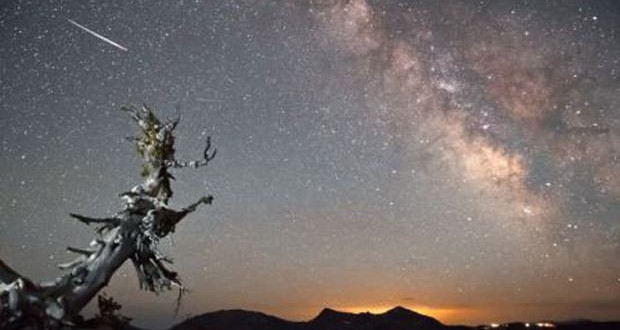An exciting new meteor shower called the Camelopardalids (Cah-melo-par-dah-lids) will peak late tonight. According to clocks the mid-latitudes in North America are predicted to have the best view of this shower. Look to the north. The showers will come out of the Camelopardalis or Giraffe constellation where the radius of the event will take place.
The exceptional Camelopardalid meteor shower
On May 24 around 7-8h UT the Earth intersects a large number of dust trails released by comet 209P/LINEAR. This event is expected to result in a potentially significant meteor shower, which may be one of the strongest in the past decade. But very little is known about the meteoroid stream that may produce the shower and anything is possible, from a barely detectable shower to a very strong outburst. The radiant of the shower, the point from which the meteors apparently radiate from is in the large, but inconspicuous constellation of Camelopardalis. The radiant is located about 10° southwest of Polaris, nearly halfway between the brightest star in Ursa Major (Big Dipper) – Dubhe and Cassiopea (RA 125°, Dec +79°). Contrary to well known annual meteor showers, such as the Perseids, Orionids and Geminids, the Camelopardalids will be very slow with their velocity being only 18 km/s.
How and where to observe
The timing of the peak, May 24 7-8h UT (2-3h EST, 1-2h CST) favours the North American continent. The radiant is circumpolar – it never sets – for latitudes above 11 °N. The best conditions will be found where the radiant is highest in a dark sky. The best locations will be near the USA-Canada border east of North Dakota. Locations further west and south will have the radiant lower in the sky and will consequently see less meteors. Locations further north will never have a fully dark sky as the Sun never goes deep enough below the horizon. Any early or late activity of the meteor shower may be visible over European and Pacific longitudes, respectively. At the time of the peak, the constellation of Camelopardalis will be at its lowest in the sky, directly below Polaris.
To observe the Camelopardalids, you need to dress warm, bring a reclining chair and watch the sky. You need no other equipment. If you decide to do so, use the IMO major meteor shower observing technique. This way your data will be in a standard format, that can readily be used for analysis. Please use the 3-letter shower code CAM for the Camelopardalids in your report. Send us your data as soon after the observations as posssible.
Camelopardalids in depth
The possibility of a meteor outburst by meteors from 209P was first pointed out by Jenniskens (2006), who predicted encounter with dust trails by this comet on 2014 May 24 around 7h UT. Since then a number of authors have published results of meteoroid stream modeling and outburst timing and strength predictions.
Contrary to other outbursting meteor showers, such as the Leonids and the Draconids, the past activity of this shower’s parent comet is virtually unknown. No meteor shower caused by 209P/LINEAR has ever been observed, on which models could be based and tested. All predictions are based on the observed three returns of the comet and backward integration of its orbit. 209P/LINEAR is a highly peculiar comet. Contrary to most parent comets of meteor showers, this comet is exceedingly faint with an absolute magnitude of only +18. Such a faint absolute magnitude implies very low activity of the nucleus and low dust production. The very low dust production was confirmed by observations by (Ye & Weigert, 2013). The comet is intrinsically about 8 magnitudes (1500x) fainter than 21P/Giacobini-Zinner and 55P/Tempel-Tuttle, parent comets of the Draconid and Leonid meteor showers, respectively.
Jeremie Vaubaillon (IMCCE) predicts a strong outburst of the meteor shower, rivaling the strongest annual showers or exceeding them by a factor of 3 or 4. Based on his model, trails produced by the comet in perihelion passages between 1803 in 1924 are encountered. Peak expected ZHR is in the range 100-400 meteors per hour, but stronger activity is not ruled out, possibly even reaching storm levels. Mikhail Maslov, using the vertical trails model, predicts the main activity to come from 1898-1919 dust trails, however, with some contribution by older trails down to at least 1763 which was the oldest computed trail. He tentatively expects the peak ZHR around 100 meteors per hour, but „storm levels are also far from being excluded“. Recent work by Ye & Wiegert (2013) concludes a meteor storm with ZHR > 1000 is rather unlikely. They also suggest meteoroid size will be skewed towards larger particles, resulting in brighter meteors. Modeling suggest a wide outburst with FWHM ~10 hours.
In contrast with meteor outbursts by Draconids and Leonids virtually nothing is known about the Camelopardalids: past activity of the parent comet is completely unknown and no past outbursts are known on which models could be calibrated. Possible strength of the outburst ranges from nonexistent to storm level, with most predictions favouring ZHRs up to a few hundred meteors per hour. Peak activity is expected around 7-8h UT.
Canadajournal/Press Releases
 Canada Journal – News of the World Articles and videos to bring you the biggest Canadian news stories from across the country every day
Canada Journal – News of the World Articles and videos to bring you the biggest Canadian news stories from across the country every day



